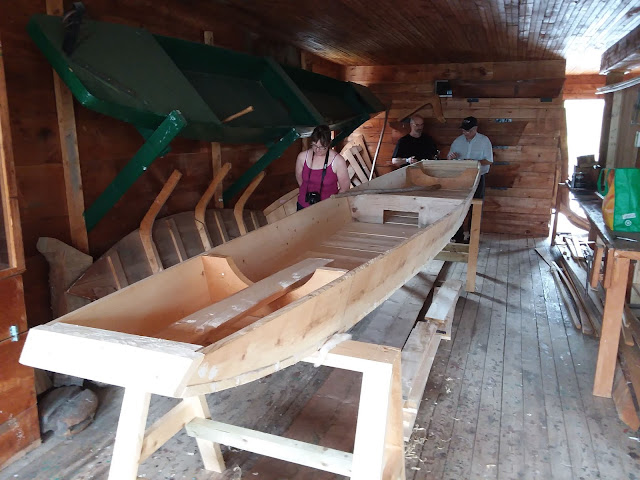Nova Scotia - part 7
(sightseeing)
July 25, 2018 - July 28, 2018
We drove from Dartmouth to Stillwater along the north portion of the southern coast of Nova Scotia - what they refer to as their Marine Drive. It's a pretty route but the roads leave a bit to be desired - especially if you're in a motorhome. Our objective was to get within striking distance of the town of Sherbrooke. In Sherbrooke is a tourist attraction called Sherbrooke Village, a collection of about 34 buildings depicting village life in the mid 1860's. The preservation and restoration effort started in 1969 and included moving several more modern buildings out of the area where the original town had begun. It's been going ever since and provides a good number of jobs for the community.
 |
| A look down one of the streets of Sherbrooke Village. |
 |
| This device is used to make small circles of metal. |
 |
| Items from a tailor's shop. The 'striped' item on the counter fits up against the tailor's body, giving him a hard surface to work from. |
 |
| Tailor's notes about how the customer wants his clothing to be made. |
 |
| The tailor's shop had samples of fabric as well as gentleman's hats for sale. |
 |
| The tailor would also need thread, buttons, snaps, hooks and eye's, etc. in order to fill his custom orders. |
 |
| Additional sewing machine along with irons and sleeve boards to press the new garmet. |
 |
| Special woodstove to head the irons. |
 |
| Special sewing machine for leather items. |
 |
| Fishing was an important part of Sherbooke as it lies right on the St. Mary's river. These men have caught 5 large Atlantic Salmon. |
 |
| Boat building was another business in town. These narrow, shallow draft boats are specially designed to be used on the St. Mary's river which is quite rocky. |
 |
| This woodworker is making the seat for a chair such as the one on the left. |
 |
| Jigs used by the carpenter to bend wood in various patterns. |
 |
| Steps in making hand made wooden spoons. |
 |
| This reddish orangish item was once a universal signal that medical help was available at this establishment. |
 |
| Sign in the Photography studio. The two women who work at this studio have been doing this for over 20 years! |
 |
| Some examples of ambrotype photography. |
 |
| The is the liquid used in ambrotype photography, so called because of it's amber color. The women photographers at this studio make up this liquid from scratch. |
Types of photographs through the years.
One last place we visited was a temperance hall where we discovered that the temperance movement was started by a group of men who where trying to help a friend who drank too much. It worked and the movement spread from there. It wasn't until much later that women were allowed to join. The temperance pledge reads as follows:
TEMPERANCE PLEDGE
I herby promise, by the help of
God, to abstain from the use of
all intoxicating liquors including
wine, beer and cider; from the
use of tobacco in any form
and from all profanity.
Signed: ________________________ Date:______________________













No comments:
Post a Comment